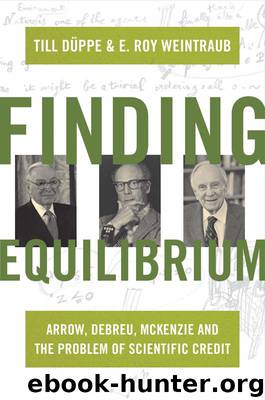Finding Equilibrium by Düppe Till Weintraub E. Roy

Author:Düppe, Till,Weintraub, E. Roy.
Language: eng
Format: epub
Publisher: Princeton University Press
Published: 2014-03-14T16:00:00+00:00
Debreu’s Path
In the months before his arrival at Cowles in June 1950, Debreu had visited Uppsala and Oslo, where he met Ragnar Frisch. It was during this period that he wrote a paper linking Pareto efficiency to equilibrium using calculus, as he noted in his list of accomplishments sent to the Rockefeller Foundation (GDP, additional carton 3). The generalization of this paper, using not calculus but convexity tools, was Debreu’s “debut” paper at Cowles in the summer of 1950. In August 1950, at the same time that Arrow presented his optimality proof in Berkeley, Debreu presented his proof of the optimality theorem at the Harvard meeting of the Econometric Society; the paper eventually appeared as “The Coefficient of Resource Utilization” (Debreu 1951a). The paper “provided a non-calculus proof of the intrinsic existence of price systems associated with optimal complexes of physical resources—the basic theorem of the new welfare economics…. This proof is based on convexity properties” (ibid., 274). In a “historical note” regarding calculus, he dismissed Pareto for not having established the conditions of an optimum “in spite of lengthy developments” and claimed that “gradual improvements [were] brought by Barone, Bergson, Hotelling, Hicks, Lange, Lerner, Allais, Samuelson, and Tintner” (ibid., 282), though none of them could shed the corset of calculus. In Debreu’s view their work represented a half a century of economic theory spent in vain attempts to be rigorous.
One of Debreu’s first tasks at Cowles was to review Arrow’s optimality proof that, like his, used convexity arguments but was less formal than his own treatment. Debreu recalled: “The Cowles Commission had an internal refereeing process and it is in this connection that I was shown the manuscript of K. J. Arrow’s paper by William B. Simpson, the Assistant Director of Research of the Cowles Commission. As I recall, W. B. Simpson asked me whether Arrow’s contribution should be included in the Cowles Commission Reprint Series, and also to comment on the substance of the paper” (Debreu, personal communication, in Weintraub 1985, 95). Debreu acknowledged Arrow’s article in the published version of the Harvard paper with a footnote pointing out that Arrow, too, had presented a paper that also “contains a non-calculus proof of the basic theorem. Unfortunately I had his manuscript in my hands for too short a time to appraise it fully here” (Weintraub 1985, 95). Arrow in his article (see ibid., 96–97) thanked Debreu for his comments (1951c, 507).
After his arrival at Cowles, Debreu began reading the same articles that used the fixed-point theorem in economics that McKenzie and Arrow were reading. His interests, however, were different. From his Bourbakian perspective Debreu was not much interested in the applied contexts in which fixed-point theorems could be employed in thinking about games, strategies, competition, price-taking, and so forth. He was instead rather taken with the fact that fixed-point theorems were topological since topological structures were one of the “mother-structures” of Bourbaki mathematics. His first encounter with a fixed-point theorem in an economic context might have been von Neumann’s and Morgenstern’s reference to Kakutani (1944, 154).
Download
This site does not store any files on its server. We only index and link to content provided by other sites. Please contact the content providers to delete copyright contents if any and email us, we'll remove relevant links or contents immediately.
Pale Blue Dot by Carl Sagan(4907)
The Rules Do Not Apply by Ariel Levy(4847)
Goodbye Paradise(3725)
Ogilvy on Advertising by David Ogilvy(3503)
Liar's Poker by Michael Lewis(3367)
Delivering Happiness by Tony Hsieh(3364)
Into Thin Air by Jon Krakauer(3308)
Purple Cow by Seth Godin(3138)
Rogue Trader by Leeson Nick(2975)
The Social Psychology of Inequality by Unknown(2937)
The Airbnb Story by Leigh Gallagher(2797)
4 - Harry Potter and the Goblet of Fire by J.K. Rowling(2650)
The Mind Map Book by Tony Buzan(2510)
Bossypants by Tina Fey(2463)
Claridge's: The Cookbook by Nail Martyn & Erickson Meredith(2359)
All the President's Men by Carl Bernstein & Bob Woodward(2326)
Six Billion Shoppers by Porter Erisman(2267)
Master of the Game by Sidney Sheldon(2240)
Alibaba by Duncan Clark(2037)
